Online Visibility. It is perhaps the number one search marketing metric. Simply put how easily can a brand be found online?
It is what us marketers spend all day doing whether we work in organic social or SEO, Digital PR or content marketing. The aim of the game is to get as many eyeballs as possible on a brand.
If there is one thing the UK’s Big Six energy companies have had over the last twelve months, it’s visibility.
Over the last twelve months Scottish Power, British Gas, E.ON, EDF Energy, OVO Energy and SSE have landed over 21,000 brand mentions in the UK press.
In this study, we have looked at which of the Big Six Energy Companies are currently getting the worst response online to both their own content and press stories and headlines that mention their brand.
Which of the six are the general public, and presumably their customers, most unhappy with?
Jump to:
- What is the energy crisis?
- How the Big Six have weathered the storm
- The UK’s least popular energy companies ranked
- What should the Big Six do next?
What is the energy crisis?
In the UK we still rely heavily on gas for home heating and cooking. Yet despite our reliance on fossil fuels to heat our homes and cook our dinner, we have one of the lowest gas storage capabilities in Europe.
This leaves the UK uniquely exposed to global market forces and their impact on energy prices.
In August 2021, the energy price cap was increased to £1,277 for the average household which came into effect in October 2021.
This was subsequently increased again on March 31st 2022, causing the energy company’s websites to crash as consumers rushed to submit their meter readings at the lower tariff.
In August of this year, it was announced that it would increase again as of October 1st. The energy price cap has now been replaced by a 27% higher ‘price guarantee rate’.
However, despite Liz Truss (wrongly) claiming that no one will pay more than £2,500, all this means is that a typical bill will increase from £1,971 to £2,500.
How The Big Six Have Weathered The Storm
British Gas
Originally called The Gas Light and Coke Company, what we now know as British Gas was the world’s first public utility company.
When the Thatcher government introduced the Gas Act 1986, the company went private that December.
Today it is the largest supplier of domestic gas in the United Kingdom, and one of the largest suppliers of electricity.
British Gas customers are not happy, and many of them have taken to the internet to vent their frustrations.
A situation not helped by headlines boasting of massive tax rebates and huge profits.
Over the last year British Gas has been the subject of 1,627 online articles, with few of them flattering.
According to our report, British Gas is the least popular energy provider online with a Consumer Unhappiness Score of 96.96%.
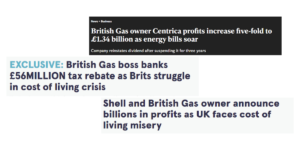
British Gas Consumer Unhappiness Score: 96.96%
E.ON
Based in Essen, Germany, E.ON is one of the world’s largest investor-owned electric utility service providers.
In 2019, E.ON became the first of the Big Six UK energy companies to switch all of its British electricity customers entirely to renewable electricity.
Unfortunately, this good news story has been eclipsed since with spectacular PR gaffes.
In January 2022, the company sent UK consumers socks to help them stay warm amidst the energy crisis.
This was followed up by a tweet in March in which a customer service rep accused Money Saving Expert Martin Lewis of ‘bringing down Britain’.
It is easy to see how they have become the second-most unpopular energy company in the UK.
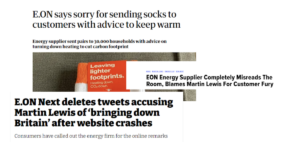
89.47% E.ON Consumer Unhappiness Score
EDF Energy
Despite being one of the Big Six UK energy providers, EDF Energy (formed in 2002) is owned in its entirety by the French State.
In 2009, EDF took control of the nuclear generator in the United Kingdom, making them one of the largest providers in the United Kingdom.
Over the last year, EDF Energy has been the subject of a staggering 8,246 online articles.
Many of these focus on the perceived unfairness at the difference between prices for French customers compared to those in England.
This could be at the heart of their rating as the third-most unpopular energy company in the UK with a Consumer Unhappiness Score of 72.78%.
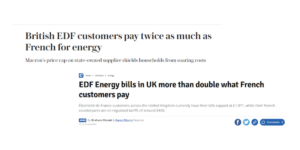
72.78% EDF Energy Consumer Unhappiness Score
OVO Energy
Founded by entrepreneur Stephen Fitzpatrick, OVO Energy began trading in September 2009 by selling electricity and gas to supply domestic properties across the UK.
In January 2020 they completely acquired the retail arm of SSE, joining the Big Six and becoming the country’s third-largest domestic energy supply company.
OVO have only received a fraction of the online coverage other members of the Big Six have received over the last year with 442 online articles.
However, their failure to read the room with their content marketing in January 2022 landed them headlines everywhere from the BBC to the Financial Times.
In fact, the advice on their website which suggested customers should cuddle pets for warmth went global, landing coverage on the American news site CNN.
Out of the Big Six, OVO is the fourth least popular with a Consumer Unhappiness Score of 59.03%
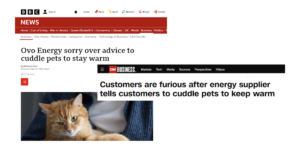
59.03% OVO Energy Consumer Unhappiness Score
SSE
SSE was formed via a merger between two former public sector electricity supply authorities to create Scottish and Southern Energy in September 1998.
The North of Scotland Hydro-Electric Board, founded in 1943 and the Southern Electricity Board, which was created in 1948 were both privatised in 1990/91 before merging seven years later.
SSE has been the subject of 6,209 online articles in the last 12 months and became the villain of one of the more unusual PR crises in June 2022.
A representative from SSE broke into the home of a Hull couple to install an energy meter by force despite the couple not being SSE customers.
Although an SSE spokesperson later apologised for the inconvenience, it was too little, too late to quash the headlines.
Their goodwill with consumers was already waning when in May 2022 their chief executive, Alistair Phillips-Davies, attempted to defend profits and dismiss the need for a windfall tax.
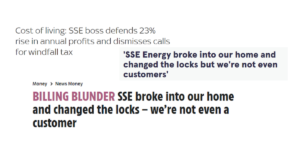
SSE Consumer Unhappiness Score 42.70%
Scottish Power
Despite its name, Glasgow-based Scottish Power is actually a subsidiary of Spanish utility firm Iberdrola following a £11.6 billion takeover in 2006.
The company supplies electricity and gas to homes and businesses around the United Kingdom and generates power for supply to the National Grid as part of Europe’s third largest utility company.
Compared to the rest of the Big Six, Scottish Power seems to have largely escaped the terrible headlines, even though the activist group Don’t Pay UK stormed their Glasgow office in August. Perhaps that is why their Consumer Unhappiness Score is only 12.35%.
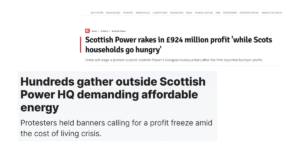
Scottish Power Consumer Unhappiness Score 12.35%
The UK’s Least Popular Energy Companies Ranked:
| Position | Company | Consumer Unhappiness Score |
| 1 | British Gas | 96.96% |
| 2 | E.ON Energy | 89.47% |
| 3 | EDF Energy | 72.78% |
| 4 | OVO Energy | 59.03% |
| 5 | SSE | 42.70% |
| 6 | Scottish Power | 12.35% |
What should the Big Six do Next?
We spoke to Crisis Communications Expert Carmel O’Toole, a Senior Lecturer in Crisis Communication at Sheffield Hallam University and PR and Crisis Communications Specialist Patrick O’Keefe from Different Narrative about what, if anything, the Big Six should do next to increase their standing with the British Public.
‘One of the golden rules of effective crisis communications is to tell it fast and keep talking. In a communications vacuum, misinformation and rumour are quick predators to step in and fill the void. In the absence of strong and clear corporate communication, worried consumers and fact-hungry journalists will go to the next most willing opinion for a take on what’s happening. That might be the bloke down the online ‘pub’ or basically anyone with a compelling opinion. It is much harder to correct false information once it’s out there, than to get it right from the start.
These days the funnel of mainstream media is much less dominant, with direct communications via company social media feeds often the first choice for concerned consumers. For companies in the teeth of a social or political storm, which in this case is the UK and global energy crisis, that creates an issue all on its own. The scale of consumer contact can be overwhelming for resource-limited social media monitoring teams. Scheduled posts and tweets just won’t cut it if you want to ensure an authentic voice and the genuine corporate compassion that’s essential in such worrying times. The dilemma, to respond or not?
More recently coverage of the pay and bonuses packages to ‘Fat Cat Energy Bosses’ – (The Sun, the Mail and the Mirror, August 10, 2022) continued to feed the perception of an industry completely disinterested in its customers’ predicament. BP boss, Bernard Looney, reported to be earning £11.4m this year alone, is attributed with the ‘cash machine’ reference to soaring profits. In crisis communications, perception is as good as reality. If folks think it, you need to address it.
My advice is always to have a crisis communications strategy in place before a storm hits. It won’t prevent negative comments, but it will position you much more robustly to respond and recover. Repeated industry research has shown that the best companies, those who successfully weather the storm, are those with a plan. Knowing your company inside out and really understanding what your stakeholders are feeling on any given day should be a given.
So have a plan, keep talking, understand your key audiences and be creative about how you can help your customers. Sadly, there’s precious little evidence of that happening at the moment.’
Carmel O’Toole, Senior Lecturer in Crisis Communication at Sheffield Hallam University.
‘The old adage states that there’s no such thing as bad publicity. Unfortunately, that’s not usually the case, and with the rise of social media, it couldn’t be more important in 2022 for businesses to protect their reputation from potential crises.
Businesses have overcome Brexit fallout and the COVID-19 pandemic, but now, as the cost-of-living crisis really grips the nation, more businesses are coming under the microscope as price hikes and industrial action cause consternation among the British public.
All businesses, particularly those operating a public-facing service, should generate a crisis communications strategy – a car insurance of sorts that provides protection when it’s required, but hopefully is never needed to be called upon.
Bring together your key marketing and communications personnel and liaise with the CEO and other key stakeholders to identify potential risks. Who should be the main point of contact on any communications, for example? Develop a strategy for the various scenarios that could pose a danger to your reputation and identify/create responses that align to the business’ objectives and tone of voice.’
Patrick O’Kane, Crisis Communications Specialist at Different Narrative.
Insight from the Salience Team:
Brett Janes, Director at Salience, said:
‘The old mantra that there’s no such thing a bad publicity doesn’t hold up so well in our world of digital marketing. Search and social algorithms are, if not successfully right now, striving to contextualise coverage and mentions around the web and use that information to change how and where it is shown.
The Big Six now have a tough job of balancing out all that negative coverage. I think the strongest place they could could be in the media conversation is front and centre, being transparent about what they’re doing to make life easier for consumers.’
Nat Took, Content Strategist at Salience Search Marketing said:
‘Keeping on top of your content is a vital part of any online strategy. As with everything, changes happen, and it’s not just trends that change. Something that might have been “just a bit of fun” could suddenly invite backlash.
Let’s face it, a few years ago, the advice to cuddle your pets to stay warm would’ve been seen as cute advice, that no one would’ve really taken seriously. But in January 2022, with the energy crisis looming, this advice earned OVO Energy some well-deserved criticism.
It’s important to know what content you have on a website and this applies to new and older content. Not just so you don’t repeat yourself, but so something can be changed when circumstances change. Whatever you do, don’t put something live online to just forget about it!’
About Salience: Since 2009, we’ve provided search marketing services for household names, challenger brands and ambitious start-ups across retail, lead generation, finance & charity sectors. We work on agile principles, born from the belief that marketing challenges rarely come with six months’ notice, so there’s no point in making plans that far in advance.
Methodology:
Data on Facebook reactions were pulled for the social media accounts of all of the big six energy companies using Buzzsumo. This was used to work out the proportion of angry to love reactions. Data on likes, posts and followers were all pulled from Social Blade for all of the big six energy companies’ twitter accounts. This was then used to calculate the number of likes they would achieve if they had 100,000 followers. These two metrics were then normalised within the dataset to be between 0 and 100 and averaged to calculate a Consumer Unhappiness Score.
